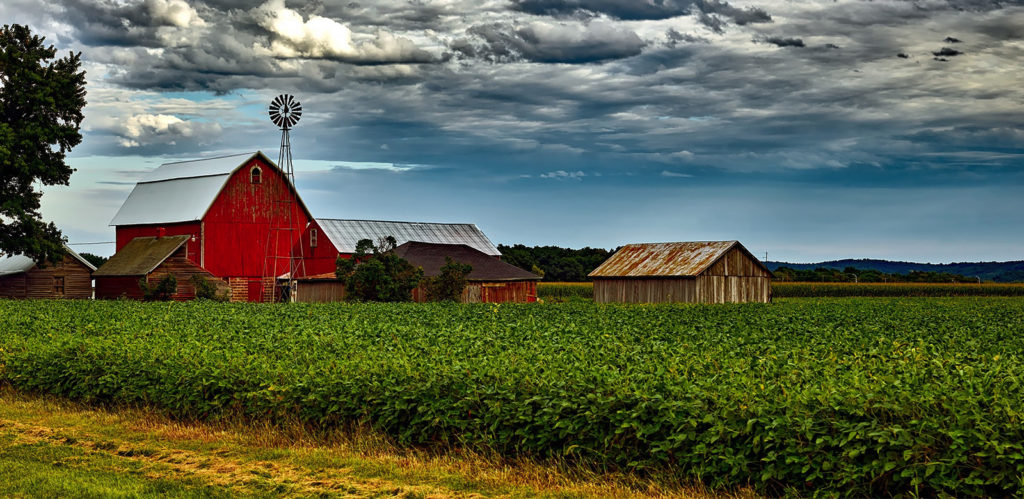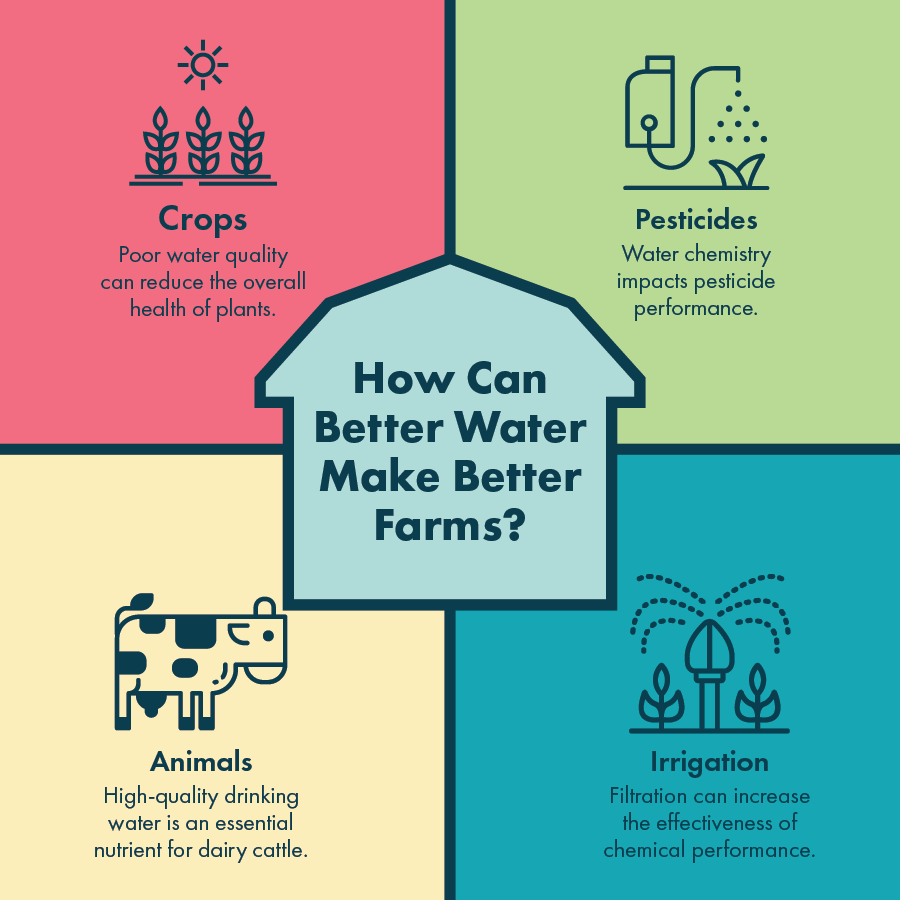How Does Water Quality Affect Farms?
Water is an essential nutrient for crops, animals, plants and wildlife. Because it plays such an instrumental role on farms, water quality really matters.
Posted in
Commercial Products,
Culligan Nation,
Culligan Solutions,
Reverse Osmosis,
Water Filtration System,
Water Problems,
Water Treatment

Crops
Essential nutrients like sunlight, water and air are necessary for crops, plants and wildlife. Different crops need different types of soil and nutrients. But there is one nutrient they all need. And it is quality water.
Poor water quality on farms can reduce the overall health of plants. It results in slowed growth, poor aesthetics of the crop and even gradual death.
There are several factors responsible for water quality. Including alkalinity, pH and the presence of soluble salts.
High soluble salts have the potential to injure root systems. Which interferes with water and nutrient uptake. High soluble salts can also build up in plant leaves. For instance, causing the edges to appear burnt or dried out.
Meanwhile, high alkalinity water adversely affects pH. And this also interferes with nutrient uptake and causes deficiencies in the crop.
Animals
Recent studies show that high-quality drinking water is an essential nutrient for dairy cattle. The most common water problems for dairy farms include excess iron, sulfate, chloride and nitrates. And these contaminants affect the health of the cow and their milk production.
Nitrates in water affect reproduction performance. While sulfate can cause diarrhea, dehydration and fluid loss. But, it's important to note that young calves are especially impacted by these contaminants.
To clarify, cows taste water the same way humans do. Therefore, if the water tastes bad, the cows will drink less. And this causes a number of different problems with dehydration and decreased appetite.
How many gallons of water should dairy cows drink?
On average, dairy cows drink anywhere from three to thirty gallons of water per day.
The daily water intake of a dairy cow depends on several factors. Such as weight, age, stage of milk production and environmental impacts.
For every 100 pounds of weight, a cow should drink one gallon of water.
But this rule only applies to cooler weather. If the temperature is warmer, cows should have nearly two gallons of water for every 100 pounds.
Plus, cows producing milk need twice as much water. So in the hot summer months, a lactating dairy cow needs roughly four gallons of water per 100 pounds of weight.
Irrigation
What is irrigation?
Irrigation is the supply of water to crops or land. And there are several different methods of irrigation used by farmers across the country.
Flood or Furrow Irrigation
Also known as surface irrigation, flood or furrow irrigation is the practice of digging trenches through crop fields and filling them with water. This technique is still largely practiced around the world. Especially in less-developed areas.
Drip or Microirrigation
Drip or microirrigation is a watering system using pipes with small holes. With this method, water slowly drips onto the plants, roots and stems.
While the pipes can be placed anywhere, they are traditionally stored under-ground or slightly above the ground where the crops are planted.
Spray or Sprinkler Irrigation
Spray or sprinkler irrigation requires large machinery to operate. This machinery sprays water over a common area. The method of water distribution is similar to rainfall.
Unlike a flood or drip irrigation system, much of the water sprayed out of the system evaporates before even reaching the crops.
Not only do spray irrigation systems face challenges with evaporation, but they also battle strong winds. As a result, some crops may be over-watered, while others do not get enough water.
Why Does Water Quality Matter to Irrigation?
The quality of water on a farm directly impacts the effectiveness of irrigation. If the water contains suspended solids or other contaminants, pipes, valves and nozzles could become clogged.
Suspended solids commonly found on farms include sand, soil, leaves, organic matter, algae and weeds. Water filtration prevents clogging and other problems caused by these materials.
Pesticides
A pesticide is a substance farmers use to protect crops and animals from harmful insects or organisms. Pesticides come in different categories for insects, plants, rodents, bacteria and fungi. So a farmer sprays a pesticide in order to fix a specific threat to the crops.
Water quality directly impacts pesticide performance.
Reverse Osmosis filtration systems reduce up to 99 percent of contaminants like aluminum, iron, magnesium and more. These contaminants and minerals cause problems and contribute to poor water quality on farms.
Sometimes, if water quality is too poor, farmers have to re-apply the pesticide. Which costs them more money, chemicals and time. A Reverse osmosis filtration system can maximize the bottom line and enhance yields.
What is Osmosis?
Let's break down the process of osmosis.
Osmosis is the passing of a solvent, like water, from a lower-concentrated solution to a higher concentrated solution. And a semipermeable membrane separates the two solutions.
When both solutions are in equal concentration, the flow stops. Because it does not require energy in order to take place, this is considered passive transport.
So What Is Reverse Osmosis?
Like its name implies, reverse osmosis is the opposite of osmosis. Instead of balancing two solutions, the external force of pressure reverses the natural flow.
Since contaminant molecules are larger than water molecules, only water passes through the semipermeable membrane.
Therefore, applying more pressure to the contaminated water makes the reverse osmosis process more effective.
What Are the Steps Of Reverse Osmosis Filtration?
While different companies and brands might vary slightly, this process applies to most reverse osmosis systems. Which can be broken down into four distinct steps.
Let's explore the steps.
First, pressurized water goes through a particle filter. Which removes impurities like salt, sand and sediment.
Next, water passes through an activated carbon filter. As a result, minerals and contaminants like chlorine, mercury, copper and pesticides become trapped. These first two steps are identified as the pre-filtration stage.
After pre-filtration, pressurized water forces its way through the semipermeable membrane. This is the reverse osmosis step.
In order to give you an idea of the membrane's filtration power, the diameter of one human hair is about 100 microns wide. But Culligan RO Systems have spaces in the membrane that are approximately ONE micron wide.
Finally, the removed contaminants flush away in the discharge stage. While the treated water moves to a storage tank.
But before the treated water reaches a faucet, it undergoes a final activated-carbon filtration to improve taste and quality for use.
What Does Reverse Osmosis Remove*?
Few filtration systems remove all contaminants. But reverse osmosis significantly reduces some of the most dangerous impurities. So what contaminants does reverse osmosis actually reduce?
Mercury
Mercury found in water comes from the natural degassing of the earth's crust. And from human activities such as burning fossil fuels. Too much mercury in the body damages the brain, kidneys, or even a developing fetus.
Lead
There is no safe level of lead exposure, especially for children. Plus, this contaminant cannot be seen, smelled or tasted. So the only way to know whether lead is in your water is to test for it.
Chlorine
While aesthetics are not necessarily health-related, they affect the taste and odor of your water. If you don't want your water tasting or smelling like chlorine, an RO can take care of that.
Chromium-6
Chromium-6 is also called hexavalent chromium. And it's an industrial chemical that is found in the drinking water of all 50 states. Chromium-6 is a known carcinogen. Which has been linked to cancer, reproductive issues, asthma attacks and other severe health effects.
Sediment
Cloudiness or haziness in water can be caused by high sediment levels. Higher sediment levels in drinking water increase the odds of developing a gastrointestinal disease.
Chloramine
Chloramines are a derivative of ammonia and contribute to an altered taste or smell in your drinking water.
Over 90 Additional Contaminants
A Culligan Reverse Osmosis drinking water system is certified to reduce every EPA-regulated contaminant. Which is more than 100 in total.
Conclusion
Water is an essential nutrient for crops, animals, plants and wildlife. And the quality of water matters, especially on a farm.
Filtered water can increase productivity of pesticide performance, provide high-quality drinking water for animals and increase the overall health of plants.
So contact your local water expert today. Whether you're a farmer, or you're just interested in having your household water tested, we're always happy to help.
Sources:
Ensure that your farm has safer, cleaner water. Get started with a free water test from your local Culligan water expert today!
FREE WATER TEST

